Globally addressing Jeju 4·3 through peace exchanges
Globally addressing Jeju 4·3 through peace exchanges
Jang Yoon-sik, Head of the Memorial Project Team

+++ The State Rehabilitation Management Commission of Mongolia holds the opening ceremony of its special exhibition at the gatepost of the Jeju 4·3 Peace Park.
Addressing Jeju 4·3 on a global scale has been pursued over several decades and will continue into the future. The purpose of globally addressing Jeju 4·3 is not confined to gaining attention from overseas to the nation’s past wrongdoing. Rather, its ultimate goal extends to sounding the alarm and bringing an end to human rights abuses, war crimes, and acts of violence around the world, which often take the form of devastation, massacres, and state violence. This can be achieved by building domestic and international solidarity over cases that took place in similar historical settings, with the resulting distress and torment expected to be resolved through peace exchanges.
A growing mood is sensed for the resumption of peace exchanges inside and outside Korea, which have long been stalled during the COVID-19 pandemic. The Jeju 4·3 Peace Foundation recently embarked on its exchanges with Okinawa and Mongolia concerning the Battle of Okinawa and the Inner Mongolia People’s Revolutionary Party purge incident, which claimed the lives of 120,000 Okinawans and 100,000 Mongolians, respectively. Efforts have also been made to give curated tours of the Jeju 4·3 Peace Park to diplomatic missions to the Republic of Korea. This article introduces the latest activities of Jeju 4·3 activists to foster exchanges and examine remaining tasks. <Editor>
An encounter with the suffering of Okinawans
“An island scarred with deep, lingering historical wounds but also overrun with tourists who are attracted to its beauty.” This is not a depiction of Jeju Island, but of Okinawa, the southernmost prefecture of Japan. How could the two different islands seem so similar in this contect? Just as what happened over the course of Jeju 4·3 has influenced the lives of Jeju islanders, the Battle of Okinawa during the Pacific War has had an immense impact on the lives of Okinawans. The two historical cases also occurred at roughly the same time, causing lasting, unhealed pain to those involved.
On June 23, 2023, members of the Jeju 4·3 Peace Foundation attended the Memorial Ceremony to Commemorate the Fallen on the 78th Anniversary of the End of the Battle of Okinawa. The itinerary included a visit to the Okinawa Prefectural Peace Memorial Museum and some representative sites of the island’s sorrowful past.
Battle of Okinawa: The ‘typhoon of steel’
The Battle of Okinawa was fought between March 26, 1945, when United States forces captured the Kerama Islands surrounding Okinawa and Sept. 7 of the same year when Japanese representatives signed the official Instrument of Surrender. The bombardment of Okinawa by the U.S. military began in late March and lasted for about nine days, with a massive number of shells raining down on the island. Nearly everything tangible ended up being burned and destroyed. Along with the countless lives lost, the traditions of the Ryukyu Kingdom were shattered and broken, and even the landscape was altered. This whole process is referred to as the “typhoon of steel.”
The Battle of Okinawa resulted in more than 200,000 deaths. Not just those serving in the Japanese military but also over 120,000 U.S. soldiers were killed due to the bloody battle. The ferocious bombshells and military operations also claimed the lives of some 20,000 Koreans. From the Japanese side, a total of 180,000 people lost their lives, including soldiers, civilian employees in the military, and non-military personnel, with more than 120,000 Okinawans included. The deaths of non-combatants far exceed those of military personnel. What is even more painful for Okinawans is that the Japanese military not only failed to protect its own people, but looted and murdered them and even and forced them to commit suicide in mass.
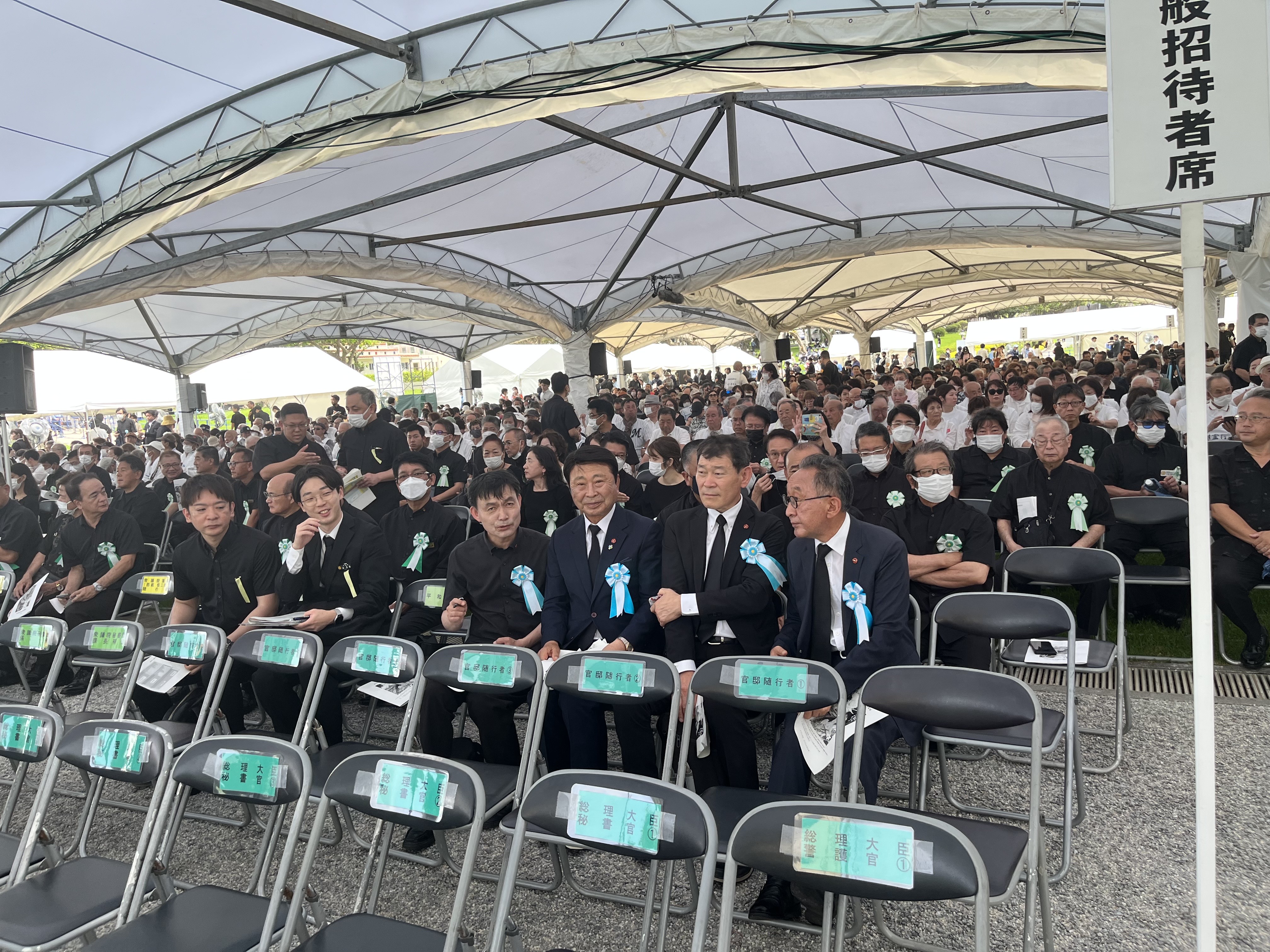
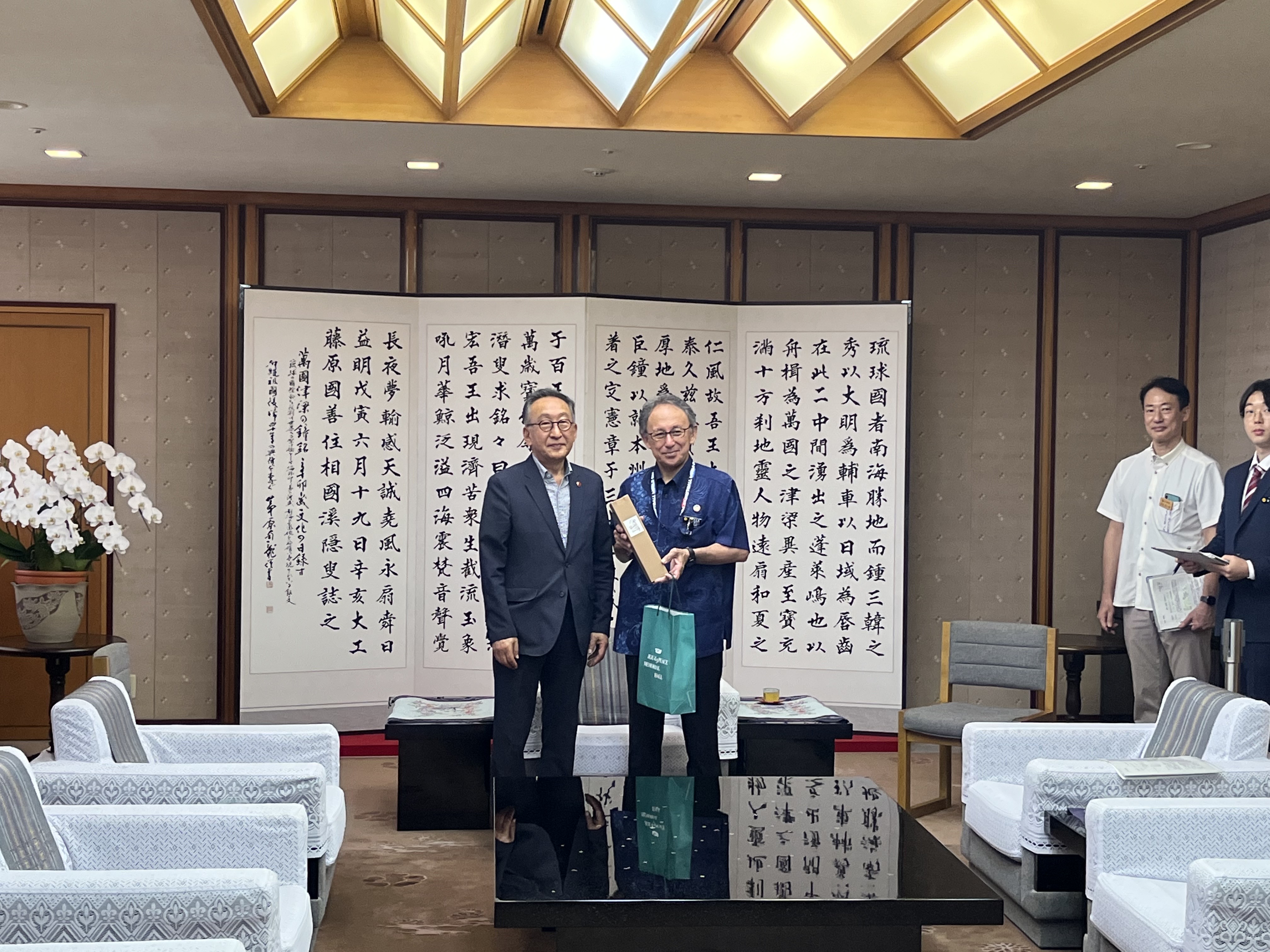
+++ President Koh Hee-bum of the Jeju 4·3 Peace Park attends the Memorial Ceremony to Commemorate the Fallen on the 78th Anniversary of the End of the Battle of Okinawa (top). Japanese Prime Minister Kishida Fumio delivers a memorial address (middle). Koh speakswith Gov. Tamaki Danny of Okinawa Prefecture (bottom).
Attendance and exchange at the memorial ceremony (commemorative day event)
The Memorial Ceremony to Commemorate the Fallen on the 78th Anniversary of the End of the Battle of Okinawa took place on June 23, 2023. The solemn ceremony, hosted jointly by the Okinawa Prefectural Government and the Okinawa Prefectural Assembly, started at 11:50 a.m. and lasted for 50 minutes. The attendees featured not only the families of victims, but also the Japanese prime minister, the Okinawan governor and the chairpersons of the House of Representatives, the House of Councillors, as well as members of the Okinawa Prefectural Assembly, and the commanding officers of the U.S. Forces in Okinawa.
Tamaki Denny, the governor of Okinawa Prefecture, issued a peace declaration during the ceremony, where he announced his commitment to regional diplomacy for peace in East Asia. He also clarified his stance concerning the marginalization and discrimination against Okinawans, respect for their human rights, and prevention of expanding a U.S. military base on the island. Above all, his strong determination was reaffirmed to stand against nuclear arms and wars and achieve enduring peace.
On June 24, President Koh Hee-bum of the Jeju 4·3 Peace Foundation visited the Okinawa Prefectural government office to meet with Gov. Tamaki. During the meeting, Koh said it was impressive that the governor and residents of Okinawa Prefecture expressed their determination to achieve peace through the declaration. “It helped comprehend the pain that Okinawans have suffered,” he added, suggesting they should establish peace exchanges between Jeju and Okinawa based on their similar experiences, including mutual visits to memorial events, exhibitions, academic events, and juvenile programs. Tamaki responded with gratitude for the visitors from Jeju to the memorial ceremony, hoping to see progress in promoting proposed exchanges.
Places dedicated to memories
Okinawa has vivid traces of the Battle of Okinawa left on various historical spots on the island, with memorial facilities established on different locations dedicated to the tormenting memories. Of the many symbolic sites, the visitors from Jeju took a tour of the Okinawa Prefectural Peace Memorial Museum, Himeyuri Peace Museum, Tsushima-maru Memorial Museum, and Sakima Art Museum.
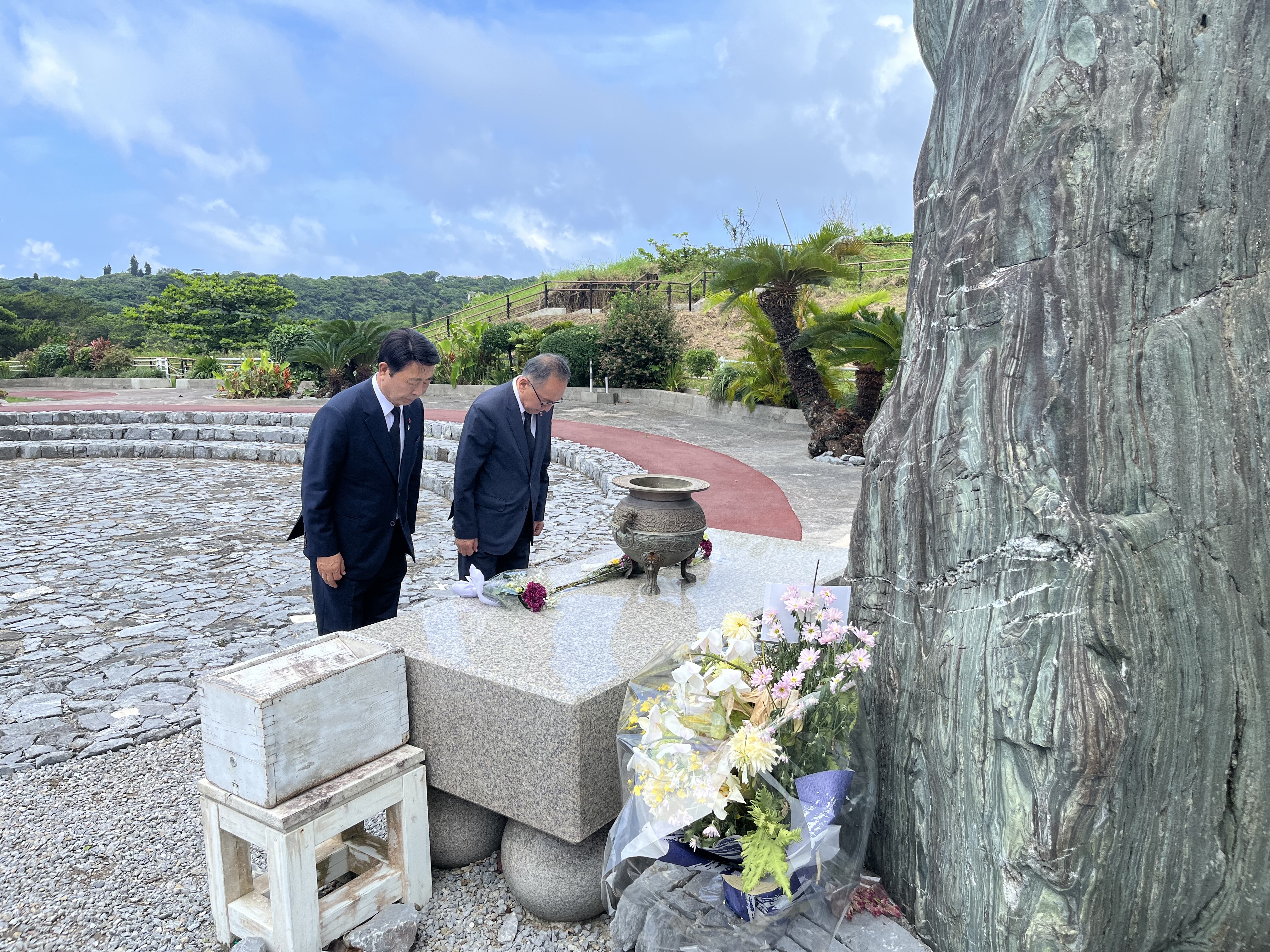
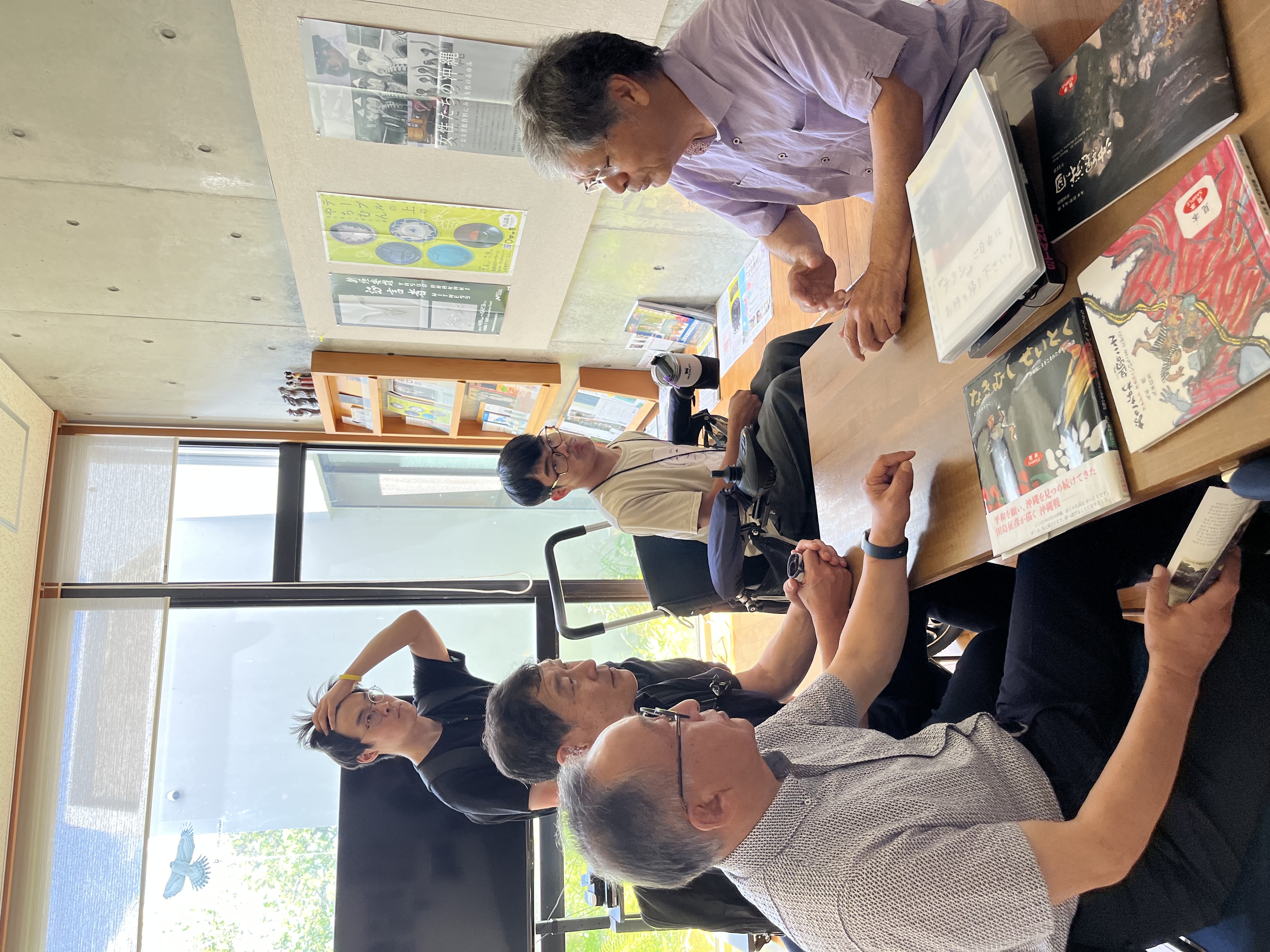
+++ The Jeju delegation visits the war memorial monument dedicated to Korean victims (top) and speaks with the director of Sakima Art Museum.
The Okinawa Prefectural Peace Museum led to controversies over whether or not they convey the truth of the Battle of Okinawa. A representative debate involves a display at the museum that highlights a bayonet held by a Japanese soldier inside a cave. Initially, the soldier was pointing his bayonet at the enemy outside the cave as if defending against the U.S. invasion. Okinawan residents who experienced the battle, however, called for the repositioning of the bayonet to aim at the residents hiding in the cave. Their claim is based on the fact that soldiers from Japan’s main islands suppressed, plundered, and killed Okinawans,, while preventing the residents from surrendering to the U.S. military. A compromise was eventually made, and the bayonet was pointed at the inside of the cave, but tilted toward someone in the air, not over Okinawan residents in hiding.
The Himeyuri Peace Museum reveals the truth and appeases the souls of 120 victims, who were included in a group of 240 student nurse corps organized by the Japanese military for the Battle of Okinawa. The young girls ended up dying in the U.S. bombardment, Japanese military acts, or coercive mass suicides.

+++ Ambassador. Svend Olling of Denmark to Korea listens to the stories about missing victims at the site of their empty graves in the Jeju 4·3 Peace Park.
The Tsushima-maru Memorial Museum was also established in memory of underage victims, especially elementary school students who weren’t afforded the opportunity to grow old due to the Battle of Okinawa. On Aug. 21, 1944, a large group of civilians including school children were evacuated to the Tsushima-maru, a Japanese military transport ship, which left Naha Port but sank the following night after it was hit by a torpedo shot from an American submarine. About 80% of the ship’s 1,788 passengers — that is, 1,484 people — were killed, including 784 children (identified as of 2012).
The Sakima Art Museum is known for the permanent display of “Illustrations on the Battle of Okinawa” by Maruki Iri and Maruki Toshi, former Nobel Peace Prize candidates who worked under an anti-war theme. The art museum was founded in 1994 after its director, Sakima Michio, incessantly struggled and finally earned the return of 1,800 ㎡ of his ancestral land that had been expropriated by the U.S. Marine Corps Air Station Futenma.
Okinawa, which accounts for only 0.5% of Japan’s total territory, hosts more than 70% of all U.S. military bases in Japan, with 18% of the island’s land being used by the U.S. military. Okinawans strongly protest against the U.S. military bases as they have long suffered from crime, accidents, and noise pollution at the hands of U.S. soldiers, as well as other threats posed to the residents’ right to live.
Jeju 4·3 introduced to diplomatic missions to Korea
Danish Ambassador visits the Jeju 4·3 Peace Park
On July 5, 2023, Danish diplomats including the country’s ambassador to Korea, Svend Olling, visited the Jeju 4·3 Peace Park to offer their condolences to the Jeju 4·3 victims. In the comment left on the guestbook, Olling shared his belief that it is of the utmost importance to remember the past and pursue reconciliation, calling for efforts to prevent the tragedy from recurring. The Danish diplomats were introduced to the tombstones for the missing victims and looked around the permanent exhibitions to learn about the disastrous past. The participants of the tour said they will make efforts to share their knowledge and impressions on Jeju 4·3 with diplomatic missions to Korea from other countries as well.
On Aug. 19, an opera titled “Sun’i Samch’on,” which is adopted from the famed novel of the same name on Jeju 4·3 by a Jeju-born activist, was performed in the Busan Cultural Center. The audience featured a range of foreign diplomats to Korea, including Mexican Ambassador Carlos Peñafiel Soto, acting Bolivian chargé d’affaires Luis Pablo Sebastian Ossio Bustillos, Nigerian Ambassador Ali M. Magashi, and Panamanian Counsellor of Foreign Trade Rosana Staniziola.
The foreign diplomats to Korea expressed their appreciation for the opportunity to learn about Jeju 4·3, while hoping the performance could be hosted in other countries as well so that the lessons from the historical event could be shared with the world. Those invited to the opera also showed keen interest in the materials introducing the Jeju 4·3 Peace Awards displayed at the lobby.
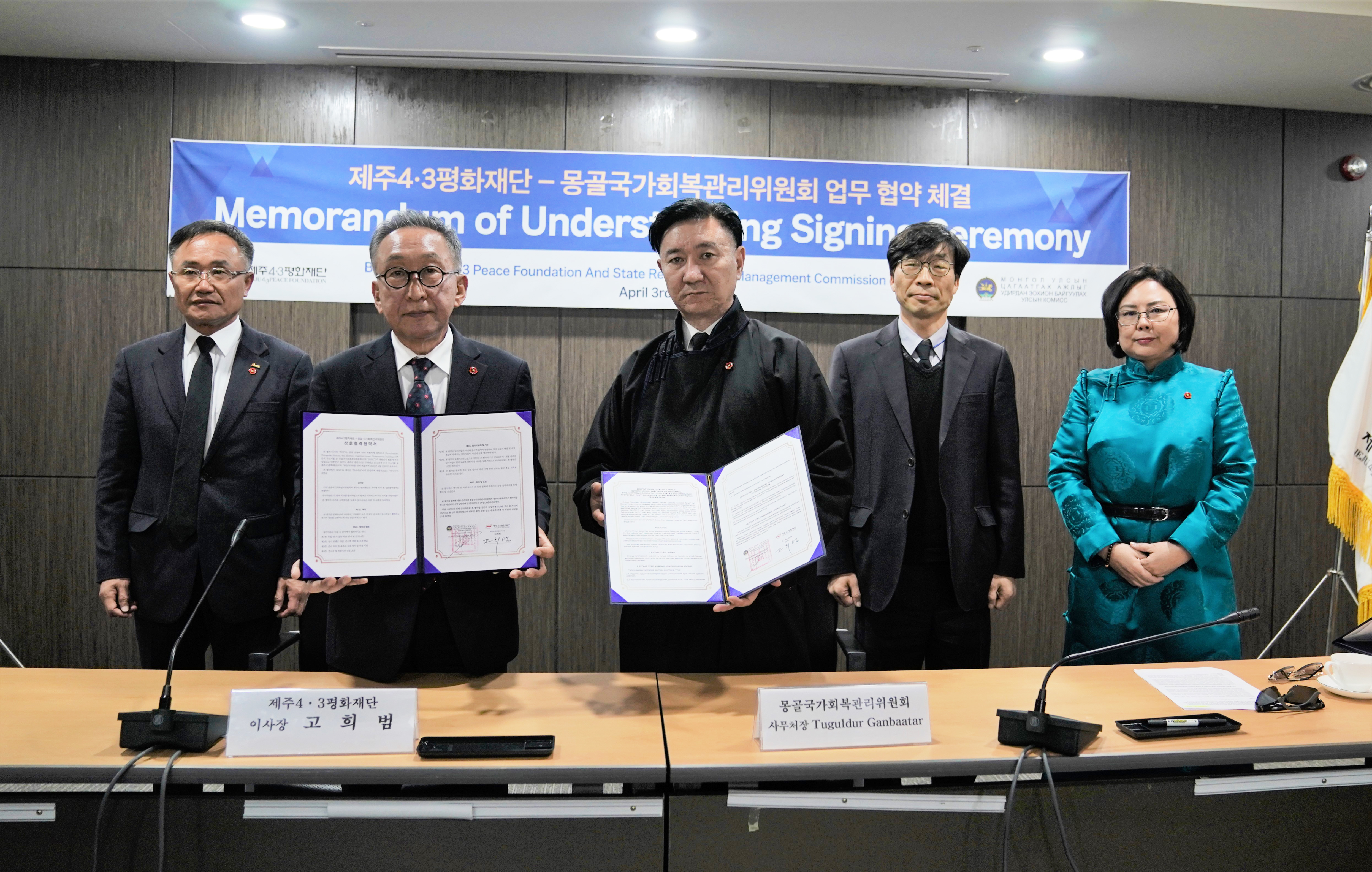
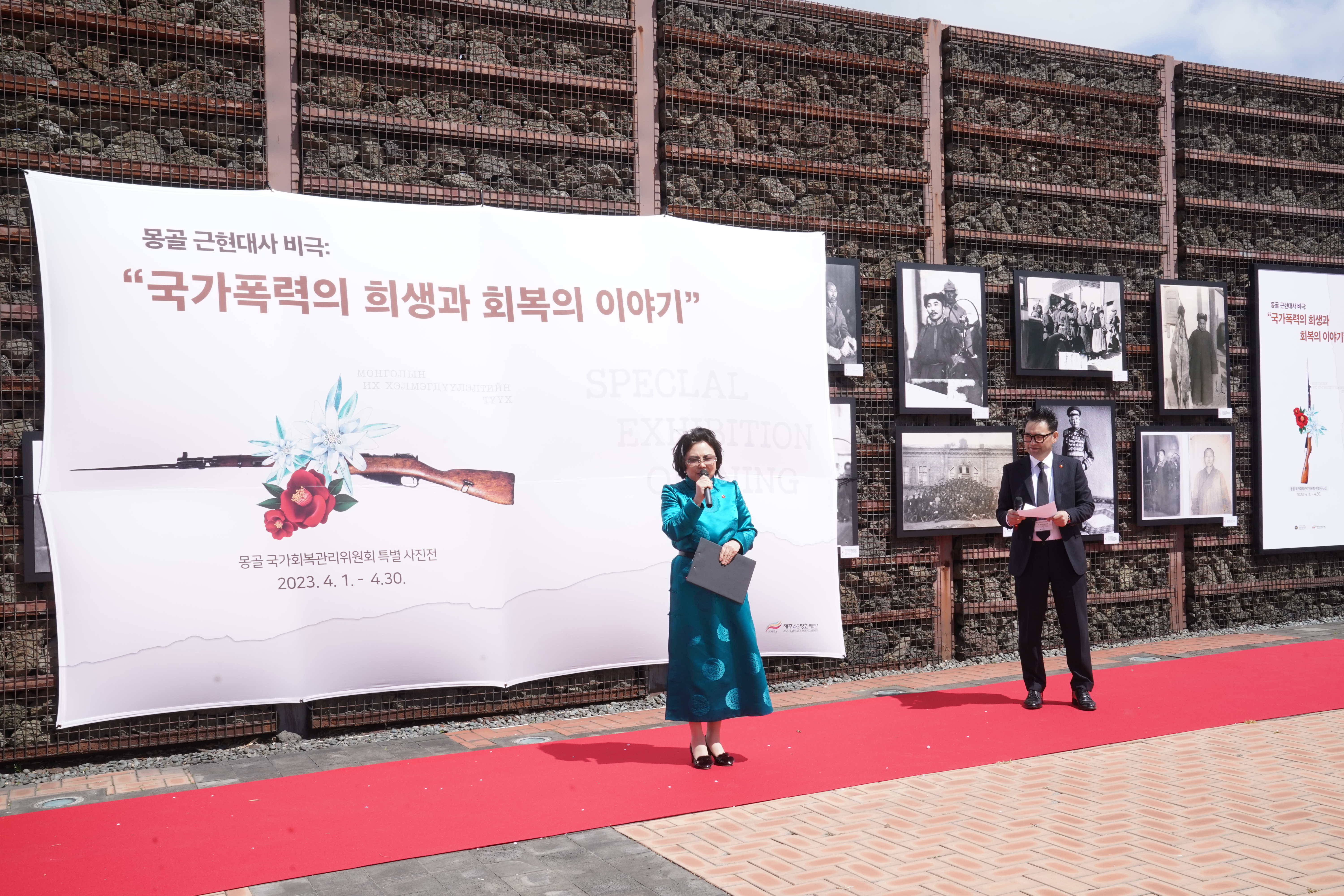 +++ The State Rehabilitation Management Commission of Mongolia sign a memorandum of understanding with the Jeju 4·3 Peace Foundation (top). Chairwoman Odontuya Saldan of the SRMC gives an opening speech for the special exhibition.
+++ The State Rehabilitation Management Commission of Mongolia sign a memorandum of understanding with the Jeju 4·3 Peace Foundation (top). Chairwoman Odontuya Saldan of the SRMC gives an opening speech for the special exhibition.
State Rehabilitation Management Commission of Mongolia attends Jeju 4·3 memorial ceremony, with mutual exhibitions scheduled to be held
On April 3, 2023, the State Rehabilitation Management Commission of Mongolia attended the memorial ceremony for the victims of Jeju 4·3 held in the Jeju 4·3 Peace Park. The Mongolian delegation held a Special Exhibition at the gatepost monument of the Jeju 4·3 Peace Park, titled “Tragedy in Contemporary Mongolian History: Rehabilitation of Victims of State Violence.” On the same day, the SRMC and the Jeju 4·3 Peace Foundation also signed a memorandum of understanding.
Odontuya Saldan, chairwoman of the SRMC and vice-chairwoman of the Mongolian Parliament who led the Mongolian delegation, said the SRMC will learn from the Jeju case and is looking forward to building strong cooperation.
In Mongolia, the Inner Mongolia incident (or the Great Purge) occurred during the communist and democratic transitions between 1921 and 1990, when state violence led to large-scale civilian deaths. The SMRC was established by presidential decree in December 1990 to investigate the case and work for related compensation and education.
Under the recently signed MOU, a special exhibition on Jeju 4·3 will be held at the National Museum of Mongolia for a month from Sept. 10, 2023. Officials of the Jeju 4·3 Peace Foundation led by President Koh Hee-bum will attend the Mongolian memorial ceremony and the opening ceremony of the exhibition, with the visit to the Mongolian Parliament and memorial facilities and an interview with the local media scheduled afterwards. During the official visit, the Jeju delegation will work to raise Mongolian public awareness of Jeju 4·3 and discuss promoting a broad range of exchanges and cooperation in the future.
Conclusion
Similar tragedies to Jeju 4·3 have occurred in different parts of the world, particularly in East Asia. Such events include the Battle of Okinawa, Taiwan’s 228 Incident, the Nanjing Massacre, and theGreat Purge of Mongolia.
It is anticipated that expanded interaction will create momentum for shared recognition that these events are not limited to specific regions but are a common historical tragedy that goes against the universal values of human rights and respect for life. This calls for solidarity, exchanges, and action for peace with regions that have suffered similar tragedies. Efforts in this sense will lead to the prevention of any such events from recurring and serve as a bridgehead to secure peace.